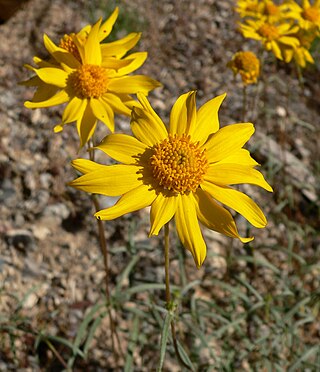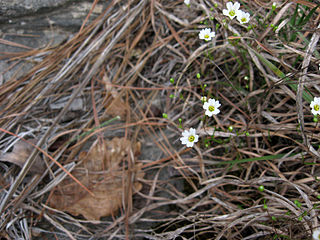
Coreopsis is a genus of flowering plants in the family Asteraceae. Common names include calliopsis and tickseed, a name shared with various other plants.

Eupatorium is a genus of flowering plants in the family Asteraceae, containing from 36 to 60 species depending on the classification system. Most are herbaceous perennials growing to 0.5–3 m (1.6–9.8 ft) tall. A few are shrubs. The genus is native to temperate regions of the Northern Hemisphere. Most are commonly called bonesets, thoroughworts or snakeroots in North America. The genus is named for Mithridates Eupator, king of Pontus.

Minuartia is a genus of flowering plants commonly known as sandworts in the family Caryophyllaceae.

Helianthus pauciflorus, called the stiff sunflower, is a North American plant species in the family Asteraceae. It is widespread across the Great Plains, the Rocky Mountains, and the Great Lakes region, and naturalized in scattered locations in the eastern United States and in much of southern Canada.

Viguiera is a genus of flowering plants in the family Asteraceae. It contains around 19–40 species, which are commonly known as goldeneyes and are native to the New World. These are herbs to bushy shrubs that bear yellow or orange daisy-like flowers.
Aldama sodiroi is a species of flowering plant in the family Asteraceae. It is found only in Ecuador. Its natural habitat is subtropical or tropical moist montane forests. It is threatened by habitat loss.

Heliomeris is a genus of flowering plants in the family Asteraceae, known generally as false goldeneyes.

Geocarpon groenlandicum, the Greenland stitchwort or mountain stitchwort, Appalachian stitchwort, mountain sandwort, smooth mountain sandwort, and smooth sandwort is a rare perennial which grows low to the ground in clumps linked together at the bottom. It has three to five pairs of leaves in a linear opposite pattern along the length of the slender stem. The main stem breaks into one to thirty cymes which each flower separately. The flowers are white and arise five to ten centimeters above the thick foliage. The white flower petals are six to ten millimeters long. The petals are, in turn, surrounded by five green sepals.

Aldama is a genus of flowering plants in the family Asteraceae. The native range of this genus is tropical & sub-tropical America. The genus was originally described to include one species of subtribe Helianthinae that were characterized by having pales that tightly enclosed the cypselae (achenes).

Hymenostephium is a genus of flowering plants in the family Asteraceae. It includes herbs and slender shrubs that occur from Mexico through to Venezuela and north-western Argentina.
Rhysolepis was a genus of Mexican plants in the tribe Heliantheae within the family Asteraceae. Until 2011, when botanists Schilling & Panero studied the subtribe Helianthinae based on molecular sequences of nuclear ITS, ETS, and cpDNA, coming to a conclusion that that the genus ViguieraKunth, did not constitute a monophyletic group. Among their conclusions they proposed to reclassify the genus, dividing and relocating its species in at least eleven genera: AldamaLa Llave, BahiopsisKellogg, Calanticaria(B.L. Rob. & Greenm.) E.E. Schill. & Panero, DavilanthusE.E. Schill. & Panero, DendroviguieraE.E. Schill. & Panero, GonzaleziaE.E. Schill. & Panero, HeiseriaE.E. Schill. & Panero, HeliomerisNutt., HymenostephiumBenth., SidneyaE.E. Schill. & Panero and ViguieraKunth.

Geocarpon uniflorum, the one-flower stitchwort, is a species of flowering plant in the family Caryophyllaceae. It is native to the Southeastern United States where it is primarily found in the Piedmont. Its preferred habitat is sandy or granitic rock outcrops.

Bahiopsis is a genus of North American flowering plants in the tribe Heliantheae within the family Asteraceae. It is native to the southwestern United States and northwestern Mexico, with several of the species endemic to the Baja California Peninsula.

Geocarpon glabrum, commonly called Appalachian stichwort, is a species of flowering plant in the carnation family (Caryophyllaceae). It is native to the eastern United States, where it has a scattered distribution.
Trillium tennesseense, the Tennessee trillium, is a species of flowering plant in the family Melanthiaceae. It is found exclusively within two counties in northeastern Tennessee. Due to its limited range, it is designated as a critically imperiled species.
Calanticaria is a genus of flowering plants belonging to the family Asteraceae.
Davilanthus is a genus of flowering plants belonging to the family Asteraceae.
Gonzalezia is a genus of flowering plants belonging to the family Asteraceae.
Heiseria is a genus of flowering plants belonging to the family Asteraceae.
Dendroviguiera is a genus of flowering plants in the sunflower family. Its native range stretches from Mexico into Central America. Formerly part of the Viguiera genus, until a DNA study in 2011 separated out all the shrub/tree species of the Viguiera genus.











